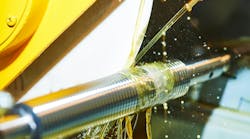Approximately 60-80% of bearing failures stem from lubrication issues. These failures frequently result in unplanned downtime, significantly impacting production and related equipment and often incurring substantial costs. The extent of these expenses varies depending on the severity of the incident and the industry involved, which contributes to overall production costs.
The primary cause of bearing failure is directly linked to lubrication, making it a significant concern. In fact, its impact on industrial equipment reliability is well established. For far too many years, bearing lubrication has been treated more randomly than in a methodical and controlled way, leading to numerous failures and unexpected downtime.
Many technicians have adopted a “preventive” lubrication approach based solely on time-based intervals, rather than conducting physical assessments of the bearings to determine the necessity of lubrication. Using time-based intervals, a grease gun is brought forth to lubricate the bearings without any prior examination.
Manual lubrication, based solely on the manufacturer’s time-based lubrication interval data, gives rise to at least the following two risks:
1. The risk of under-lubrication increases the mechanical constraints of rotation and can be the cause of failures leading to equipment breakdowns and stoppages, as well as costly corrective maintenance.
2. The risk of over-lubrication, which has been identified by many studies as the main cause of premature bearing failure.
Principle of Ultrasound Technology Applied in Lubrication
Ultrasonic technology uses specially designed sensors to detect and monitor the level of friction in bearings.
In the case of lubrication, the ultrasonic level detected by a sensor in contact with the bearing is directly linked to the friction level of the bearings. From this point onwards, the maintenance engineer responsible for lubricating bearings has two choices:
1. Manual lubrication, using a simple hand-held tool to listen to the bearings during the lubrication operation.
2. The installation of an autonomous, ultrasonic-assisted lubrication system to carry out this operation safely, efficiently and without human intervention.
Lubrication 4.0: Autonomous Ultrasound-Assisted Lubrication
A fully autonomous lubrication system completely replaces human intervention for lubrication operations. It is an intelligent lubrication and monitoring system, reducing bearing failures caused by poor lubrication practices by 80%. This also eliminates the guesswork that comes with lubrication, ensuring bearings are being lubricated at the exact right time with the exact right amount of grease.
How Does it Work?
Using ultrasound, this system measures bearing friction levels in real time, allowing potential lubrication problems and requirements to be detected at an early stage, well before the bearings are damaged. As the friction in the bearing increases due to oncoming failure, there will be a rise in the decibel (dB) level detected by ultrasound.
After setting a baseline for each bearing, you can consistently monitor the change in dB level, indicating the health of the bearing:
• +8dB above baseline indicates a lack of lubrication
• +16dB above baseline indicates damage to the bearing
• +35dB above baseline indicates critical failure
By using bearing friction as a guide, the system enables bearings that require lubrication to be precisely lubricated with the right amount of lubricant, avoiding over- and under-lubrication. As the friction level is measured continuously and in real time, even during lubrication, the system will stop lubricating on its own as soon as the friction level has dropped back down to its baseline value.
This totally autonomous system means that only the bearings that need lubrication will be lubricated when they need it and with the right amount of lubricant.
Ultrasonic technology for intelligent lubrication offers several advantages:
• Know precisely when to lubricate
• Know precisely how much lubricant to apply
• Always use the right type of lubricant
• Eliminate the risk of lubricant contamination
• Reduce lubricating time and resources
The Benefits of an Ultrasound Assisted Lubrication 4.0 Solution
• Easy to install and use
• Multiple connection capabilities: Ethernet, Wi-Fi, 4G, 5G
• Compatibility with existing systems and software
• Identify lubricating needs early on
• Lubricate as required
• Drastically improve bearing life
• Avoid over- and under-lubricating
• Reduce lubricating time
• Reduce lubricating resources
• Reduce lubricant consumption
• Reduce failure rates
Finally, it should be noted that such a solution will provide software-based, permanent, real-time monitoring of lubrication practices. For example, the OnTrak Wireless utilizes UE Insights—a Cloud platform for storing and monitoring remote data. This fully customizable platform stores all data relating to the condition and lubrication of bearings. It can be used to create monitoring dashboards and set alarm levels.
Users can choose to use pre-configured dashboards and widgets or create their own indicators. This is a web-based platform that requires no software installation and can be consulted from any type of device connected to the internet: desktop PC, laptop, tablet, smartphone, etc.
Conclusion
From a time-based periodic lubrication perspective, it is assumed that bearings need to be lubricated at regular, fixed time intervals. The question then becomes: how can these time intervals be established? This is often a combination of manufacturer’s data, valid for general cases, or for bearings mounted on manufacturer’s test benches, and approximations based on empirical experience of the same type of equipment.
By using ultrasonic technology, lubrication technicians will be able to know which bearings to lubricate, when to lubricate them, and how much lubricant to use.
These three pieces of information, especially if delivered in real time and for each bearing to be lubricated, will make it possible to considerably improve lubrication practices, reduce lubrication times and the amount of lubricant consumed, as well as drastically reducing bearing breakdown rates and unplanned downtime.








